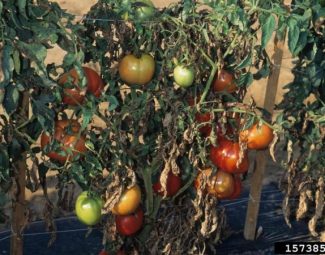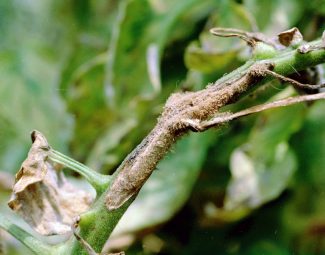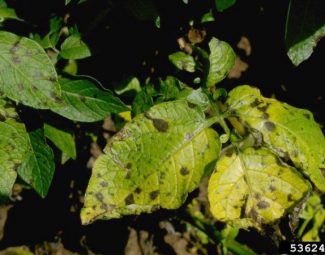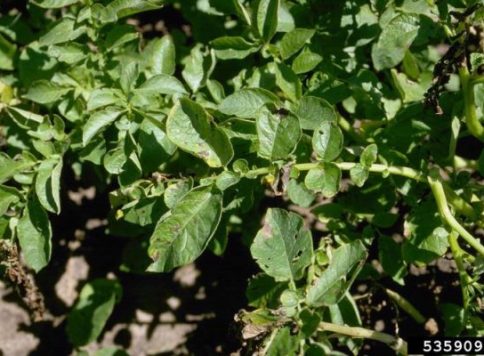Early Blight
Disease Summary Report
Alternaria Solani
General Information
- Early Blight crop hosts include: potato, tomato, pepper, and eggplant.
- Weed hosts include black nightshade and Jerusalem cherry.
- Despite its name, infection and symptoms usually develop on mature plants and plant parts, often after fruit set. Symptoms initially appear in lower, most mature leaves. If left uncontrolled, it can lead to entire defoliation of host and infection of tubers or fruit.
- Capable of infecting foliage, fruit, and tubers. Growth on fruit usually initiates in area of stem attachment. Tubers usually show symptoms after storage, often after suffering external injury. Affected areas in tubers are brown, dry and corky.
- Visual Signs – yellow concentric circles, halo dark brown, necrotic spots on foliage and fruits. Sometimes referred to as “target spot”.
- Commonly infects hosts that are compromised by insect damage, poor nutrition, mechanical damage, drought, or other stress.
- Resistant varieties are available and should be planted when possible.
Disease Cycle
- Mycelia persist in soil on dead and dying organic matter and/or tubers. Can infect tubers during periods of suitable moisture conditions. Tuber cross-infection can occur after harvest during storage, especially when tubers have suffered external damage.
- Under suitable moisture and temperature conditions, mycelia produce spores which are carried by air currents to the surface of foliage and fruit of host plants. Spore production is often more prevalent during periods of alternating rainfall and dry weather and heavy dew, rain or irrigation. Conditions favorable for development include temps of 68-86 F and humidity levels 95% or above for extended periods.
- Spores produce hyphae that are capable of invading both damaged and undamaged host foliage and fruiting tissue. Older foliage on lower parts of hosts is more likely to be infected and is usually the first to show symptoms.
- Mycelia produce dark brown spots on fruit and foliage that contain spores.
Over wintering Strategy
Overwinters as mycelia on organic residue in soil. Can also infect weed hosts during periods when crop hosts are not available.
Organic Control
- Residuce (to enhance breakdown of organic residue to organic matter)
- Jet Ag, Oxidate (contact)
- PMSLA (Biological)
- Actinovate (Biological)
- Cueva (copper soap)
Cultural Control
- Maintain good fertility and mineral balance in plants in order to reduce stress. Identify macro- and micronutrient deficiencies by performing plant tissue and soil analysis. Adjust for deficiencies with foliar and soil applied applications of appropriate fertilizers.
- Avoid or minimize factors that contribute to proliferation of inoculation such as:
- irrigation tail water from infected field (can occur in same field at row ends)
- dirty machinery
- infected transplants
- mechanical and/or insect root injury.
- Plant only certified seed and transplants free of Alternaria inoculum.
- Avoid irrigation on cool, cloudy days and at night to minimize periods of moisture on leaves.
- Stake and mulch seed beds to minimize splashing of water from soil to foliage.
- In tuber crops, tubers should be harvested only after they are fully mature and when soil and foliage has completely dried. Take measures during harvest, handling, and processing that minimize external damage to tubers.
- Avoid overwatering and areas of poor drainage.
- Control weeds that serve as hosts.
- Remove symptomatic plants or prune sections of diseased plants as soon as they are identified.
- Plant cultivars that have been identified as being early blight resistant or immune.
- Avoid planting early and late maturing cultivars in the same field. Under this scenario, one cultivar will serve as inoculant for the other.
- Destroy crop residue immediately after harvest. Plowing or disking under residue will enhance breakdown of organic residue to organic matter, limiting the amount of residue that serves as a food source for Alternaria.
- Rotate to immune crops in areas of severe outbreaks for at least 2-3 years.
More Images of Early Blight
Bibliography
- Images by Penn State Department of Plant Pathology & Environmental Microbiology Archives, Penn State University, Bugwood.org (early blight on tomato fruit and on tomato plant)
- Images by Howard F. Schwartz, Colorado State University, Bugwood.org (symptoms on leaves of potato plants)
- Images by Gerald Holmes, California Polytechnic State University at San Luis Obispo, Bugwood.org (diseased tomato plants/fruit and blighted tomato plant leaf)
- Images by Clemson University – USDA Cooperative Extension Slide Series, Bugwood.org (symptoms on stem and tomato plant leaf)
- Image by Sandra Jensen, Cornell University, Bugwood.org (symptoms in potato tuber flesh)
- Cornell University Cooperative Extension, 2008. (Conventional control materials) http://ipmguidelines.org/TreeFruits/content/CH14/default.asp#_Toc190150283
- Pscheidt, Jay, Online Guide to Plant Disease Control, Oregon State University Extension. Jan. 1, 2008. (Cultural controls) http://plant-disease.ippc.orst.edu/disease.cfm?RecordID=790
- Government of British Columbia. Brown Rot on Stone Fruits. January, 2007. ( http://www.agf.gov.bc.ca/cropprot/tfipm/brownrot.htm
- West Virginia University Cooperative Extension. http://www.caf.wvu.edu/Kearneysville/disease_descriptions/ombrownr.html
- Bush, Elizabeth, A., Keith Yoder and Alson Smith. Brown Rot on Peach and Other Stone Fruit. Virginia Tech Cooperative Extension. (Temperature range for development) http://www.ext.vt.edu/pubs/plantdiseasefs/450-721/450-721.html








